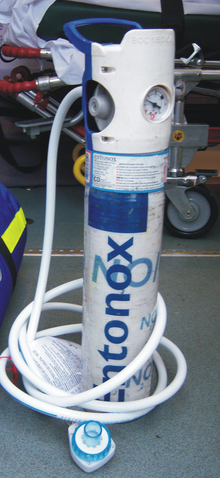
Back أكسيد النيتروز (دواء) Arabic MEOPA German Óxido nitroso (medicamento) Spanish Mélange équimolaire oxygène-protoxyde d'azote French Dinitrogen oksida dan oksigen ID 笑気麻酔 Japanese ନାଇଟ୍ରସ୍ ଅକ୍ସାଇଡ (ଔଷଧ) OR Nitröz oksit (ilaç) Turkish Nitơ oxide (y tế) Vietnamese 安桃樂 Chinese
 Entonox CD cylinder and giving set | |
| Clinical data | |
|---|---|
| Trade names | Entonox, Nitronox, others |
| ATC code | |
| Pharmacokinetic data | |
| Onset of action | 30 seconds[1] |
| Duration of action | 1 minute[1] |
| Identifiers | |
| |
| CAS Number | |
| PubChem CID | |
| DrugBank | |
| ChemSpider | |
| UNII | |
| ChEBI | |
| ChEMBL | |
| Chemical and physical data | |
| Formula | N2O |
| Molar mass | 44.013 g·mol−1 |
| 3D model (JSmol) | |
| |
| |
Nitrous oxide is an inhaled gas used as a pain medication and together with other medications for anesthesia.[2] Common uses include during childbirth, following trauma, and as part of end-of-life care.[2] Onset of effect is typically within half a minute, and the effect lasts for about a minute.[1]
There are few side effects, other than vomiting, with short-term use.[1][2] With long-term use anemia or numbness may occur.[2] It should always be given with at least 21% oxygen.[2] It is not recommended in people with a bowel obstruction or pneumothorax.[2] Use in the early part of pregnancy is not recommended.[1] It is possible to continue breastfeeding following use.[3]
Nitrous oxide was discovered between 1772 and 1793 and used for anesthesia in 1844.[4] It is on the World Health Organization's List of Essential Medicines.[5] It often comes as a 50/50 mixture with oxygen.[1] Devices with a demand valve are available for self-administration.[6] The setup and maintenance is relatively expensive for developing countries.[7][8]
- ^ a b c d e f "Anaesthesia UK : Entonox". www.frca.co.uk. 26 January 2009. Archived from the original on 31 October 2007. Retrieved 15 December 2016.
- ^ a b c d e f World Health Organization (2009). Stuart MC, Kouimtzi M, Hill SR (eds.). WHO Model Formulary 2008. World Health Organization. p. 20. hdl:10665/44053. ISBN 9789241547659.
- ^ "Nitrous Oxide use while Breastfeeding". Drugs.com. Archived from the original on 21 December 2016. Retrieved 15 December 2016.
- ^ Myers RL (2007). 100 Most Important Chemical Compounds, The: A Reference Guide: A Reference Guide. ABC-CLIO. p. 198. ISBN 9780313080579. Archived from the original on 2016-12-20.
- ^ World Health Organization (2021). World Health Organization model list of essential medicines: 22nd list (2021). Geneva: World Health Organization. hdl:10665/345533. WHO/MHP/HPS/EML/2021.02.
- ^ British national formulary : BNF 69 (69 ed.). British Medical Association. 2015. p. 878. ISBN 9780857111562.
- ^ Gregory GA, Andropoulos DB (2012). Gregory's Pediatric Anesthesia, With Wiley Desktop Edition. John Wiley & Sons. p. 1148. ISBN 9781444333466. Archived from the original on 2016-12-20.
- ^ WHO model prescribing information : drugs used in anaesthesia. World Health Organization. 1989. hdl:10665/41014. ISBN 92-4-140101-X.
© MMXXIII Rich X Search. We shall prevail. All rights reserved. Rich X Search